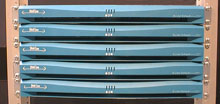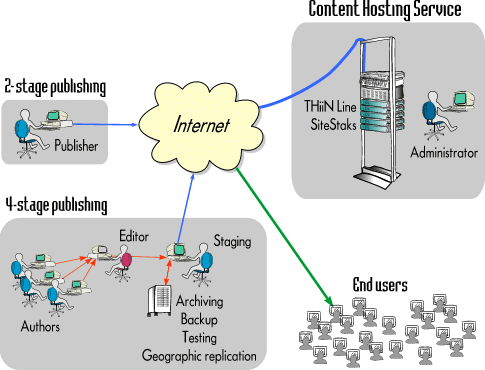
| |||||||||||||||||||||||||
|
In the content hosting business you're in the fast lane of a new industry that can be wildly rewarding, brutally punishing, or both. You've got to be able to handle fast, sometimes unpredictable growth patterns. But you can't let today's customers down. Fail in either part of the equation and your reputation can suffer badly. After that, it's hard to recover.
Heart Like a Server It could be that your customers are asking for service guarantees you canít give them. Or you're spending half your time "load balancing" by shuffling sites to different servers. Or you're trying to repair the damage of a runaway web site that trashed some critical server processes. All of this, and you're looking at a growth curve that would scare the wheels off a roller coaster. Take today's problems, multiply them by a few orders of magnitude, and you've got an idea of what the future of content hosting will bring.
The Present: Baggage from the Past General purpose servers have to carry all the baggage of their ancestors, and then some. They suffer from a "jack-of-all-trades, master-of-none" syndrome, big time. They miss the point, which is to be good at one basic thing: hosting web sites. If you're using general-purpose servers, chances are one or more of these problems will sound familiar: Configuration, installation, maintenance are major burdens. Operating systems have to be tuned for HTTP traffic; web server software has to be installed and configured; web site containment issues have to be tackled, which also requires system-level coding; and content replication — an important service-guarantee feature — has to be handled, if not today, then in the near future. Also, youíve got to produce increasingly sophisticated reports, for yourself and for your users. And reports, like every other aspect of general purpose web servers, add to a management complexity that is already nearly overwhelming. Unless, of course, you like to spend your free time reading log files. Performance and security are unpredictable, and a source of user frustration. There are countless reasons why general-purpose machines are unpredictable web site performers, and you probably already know most of them. Too many users or too many services sharing a server can wreak havoc with performance and security. If one web site gets a traffic surge, it can steal CPU cycles, I/O bandwidth, and memory from its neighbors. And if a hacker is able to get root privileges within one service, suddenly all other services on that machine are vulnerable. The future is very scary. Worst of all, youíre not ready for the future when it hits. Youíll be asked to scale your systems by 10, 100, or 1,000 times. You may have to create server farms. You might even get into geographic replication, for availability conscious clients. And youíll certainly need to be on top of advanced publishing services such as live-test/rollback. If youíre on a general-purpose web server today, chances are youíre not ready for any of those things. And in content hosting more than any other business, the future is closer than you think.
The Future is Here It comes from THiiNTM Line and it's called the SiteStakTM. Itís the beginning of a family of single-purpose servers that will give content hosts nearly infinite plug and play, mix and match capabilities — all without adding to management overhead.
It comes with a two-page startup guide, instead of the volumes of manuals you got with your current server. It has just two external connectors, for power and Ethernet. Itís small, cheap and easy — you can dedicate one to each web site, or host multiple sites on one SiteStak. Web sites can also be partitioned across many SiteStaks. But in terms of content hosting, itís a lot smarter than your present server.
And the THiiN Line SiteStak automatically gives you information for the reports you need, literally at the touch of a button. Want more? Zero administration. Built-in SNMP traps; automatic system housekeeping and tuning. Even the ability to support hundreds of web sites on one SiteStak, with containment features to protect other web sites, and enforced critical resource usage limits for CPU usage, network I/O and disk. But you donít have to worry about that. Your SiteStak will do the worrying.
Adding Value A darn good chance. For one thing, you are a lot closer to offering service guarantees than you ever thought youíd get. For another, you can offer publishers — the companies who are really going to need service — more than they can get with any other general-purpose content host.
You can give them instant compatibility with Microsoftģ FrontPage, without having to load any extra software. Best of all, you can give them the ability to put together staging services for active, high-volume applications. This is an application thatís in use by only the largest publishers today, and one that should (rightfully) scare the bits out of any content host running general-purpose web servers.
The Future is Here THiiN and SiteStak are trademarks of Data General Corporation. All other brand and product names may be trademarks or registered trademarks of their respective holders. The materials contained herein are summary in nature, subject to change, and intended for general information only. Details and specifications regarding Data General equipment and software are included in the applicable technical manuals, available from local sales representatives. All rights reserved. Copyright Data General 1997. Back to Top
|
|||||||||||||||||||||||||
 The SiteStak is a specialized appliance intended and designed to do just one thing and do it very well: serve web pages. It can hold 160,000 pages, and serve them up fast — up to 38 million hits per day.
The SiteStak is a specialized appliance intended and designed to do just one thing and do it very well: serve web pages. It can hold 160,000 pages, and serve them up fast — up to 38 million hits per day.
 It has a content-aware memory organization, so it knows to pre-fetch GIFs and other such objects instantly. It configures its network address information automatically, and knows enough to find its peers automatically in a web site cluster. So you can add another 10 or 100 web sites whenever you need them.
It has a content-aware memory organization, so it knows to pre-fetch GIFs and other such objects instantly. It configures its network address information automatically, and knows enough to find its peers automatically in a web site cluster. So you can add another 10 or 100 web sites whenever you need them.